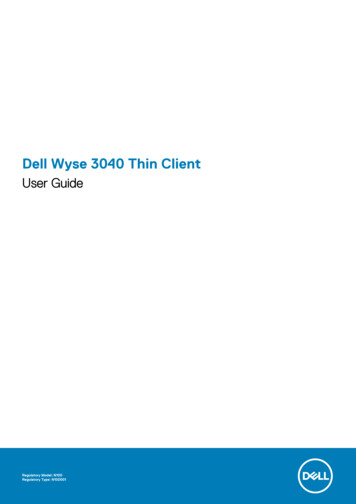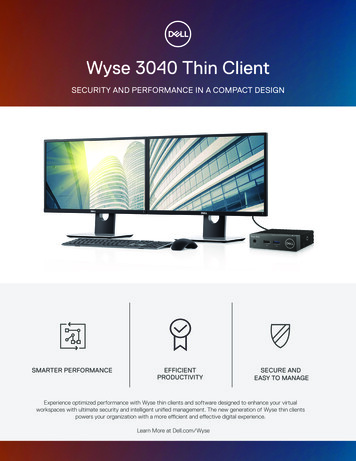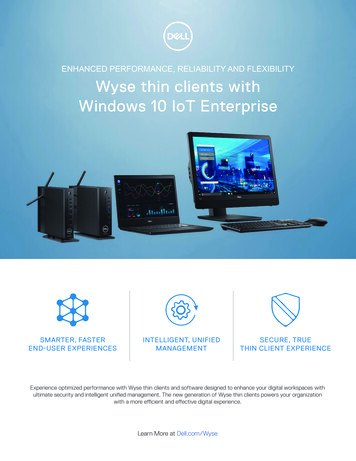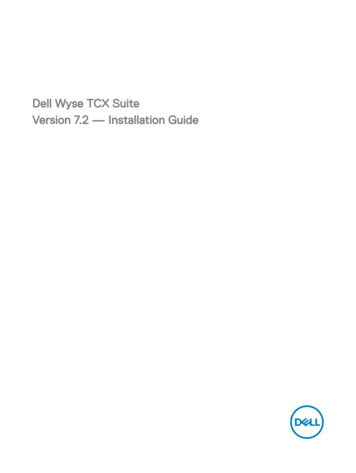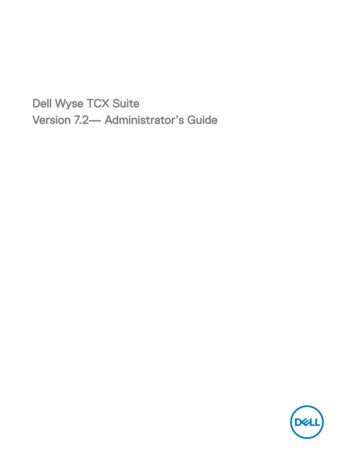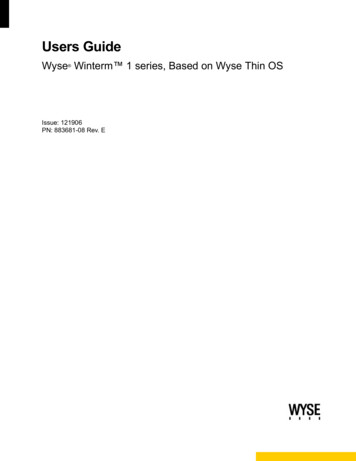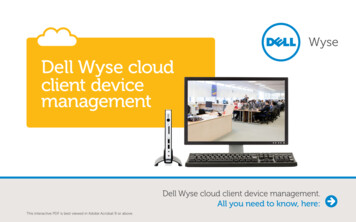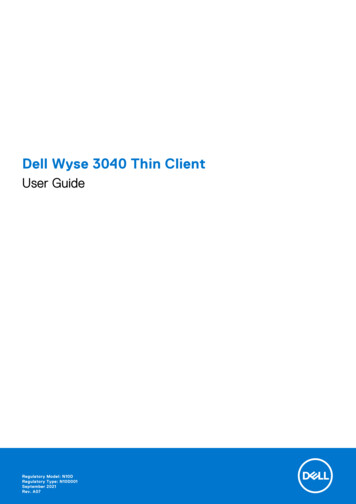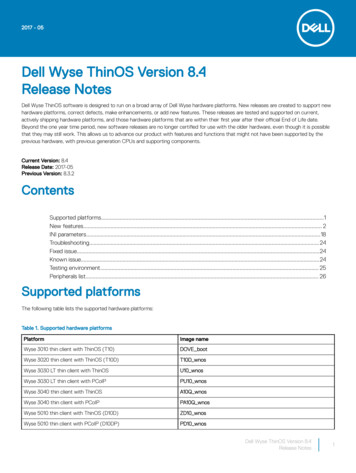
Transcription
Dell Wyse 3040 Thin ClientUser GuideRegulatory Model: N10DRegulatory Type: N10D001
Notes, cautions, and warningsNOTE: A NOTE indicates important information that helps you make better use of your product.CAUTION: A CAUTION indicates either potential damage to hardware or loss of data and tells you how to avoid theproblem.WARNING: A WARNING indicates a potential for property damage, personal injury, or death. 2017 Dell Inc. or its subsidiaries. All rights reserved. Dell, EMC, and other trademarks are trademarks of Dell Inc. or its subsidiaries. Othertrademarks may be trademarks of their respective owners.2017 - 03Rev. A00
1Welcome to Dell Wyse 3040 thin clientDell Wyse 3040 thin client is a low-cost entry level thin client platform. These thin clients have a x86 processor, which allows you torun Wyse ThinOS, PCoIP enabled Wyse ThinOS, and Wyse ThinLinux. The platform is used as a thin client by connecting to anymonitor and allows you to use a remote access client for VDI or cloud-based computing.About this guideThis guide is intended for Wyse 3040 thin clients which run Wyse ThinOS, PCoIP enabled Wyse ThinOS, and Wyse ThinLinux. Itprovides hardware specifications and OS-specific configurations to help you work with Wyse 3040 thin clients.Dell Wyse external referencesThis section provides links to technology related support and self-service sites for Dell Wyse thin clients. Dell reference guides Dell Service and Support — Latest software images Dell Wyse Device Manager — Information about Dell remote management software Dell and the Environment — Information about Dell compliance with RoHS and with the Waste Electrical and ElectronicEquipment (WEEE) Dell and e-Recycling — Information about recycling and reuse of Dell products Dell Warranty Registration* — Register your product3
2Wyse 3040 thin client hardware installationFor more information on the hardware installation, see Dell Wyse 3040 thin client Quick Start Guide.4
3Wyse 3040 thin client on ThinOSThis section provides the instructions on how to easily configure and efficiently manage Wyse 3040 thin client that runs on ThinOS.Logging on to the Wyse 3040 thin client running Wyse ThinOSWhat you see after logging on to the server depends on the administrator configurations. Users with a Classic Desktop - will see the classic ThinOS desktop with full taskbar, desktop, and Connect Manager familiar toThinOS users. This option is the default out-of-the-box experience and is recommended for terminal server environments withpublished applications and for backward compatibility with ThinOS 6.x versions. Users with a Zero Desktop - will see the Zero Desktop with the Zero Toolbar showing the assigned list of connections fromwhich to select. This option is recommended for VDI and any full-screen only connections.In any desktop case, you can select the desktop option you want (Classic Desktop or Zero Desktop) and create the connections youneed using the Visual Experience tab on the Remote Connections dialog box.To open the Remote Connections dialog box, perform one of the following tasks: Classic Desktop — Click User Name , and then select System Setup Remote Connections.NOTE: User Name is the user who is logged-on and is located at the lower-left pane of the taskbar Zero Desktop — Click the System Settings icon on the Zero Toolbar, and then select Remote Connections.Configuring the dual head display settings on Wyse ThinOSTo configure the dual head display settings:1.From the desktop menu, click System Setup, and then click Display.The Display dialog box is displayed.2.Click Dual Head tab, and use the following guidelines:5
This feature is applicable for supported dual monitor capable thin clients only.a. Dual Head—Select Mirror Mode to have the two monitors work in a matching state, or Span Mode to have the twomonitors work separately second is extended from first.b. Main Screen—Select which of the two monitors you want to be the main screen (Screen1 or Screen2). The other screenis extended from the main screen.c. Layout—Select how you want the two monitors to be oriented to each other.Horizontal — where you move between the monitors from the left and right of the screens.Vertical— where you move between the monitors from the top and bottom of the screens.d. Alignment— Select how you want the monitors to be aligned Bottom, Center, or Top.Bottom means screens are bottom-aligned in a horizontal orientation; Center means screens are center-aligned; Top meansscreens are top-aligned in a horizontal orientation.e. Taskbar (Classic Desktop Only)—Select under which screen you want the taskbar to appear Whole Screen or MainScreenGamma Supported Monitors Only— Use the Gamma Setup tab to adjust the saturation values for Red, Green and Blue onVGA connected monitors supporting gamma settings, if you feel the default settings are too light. Be aware that the GammaSetup tab will be disabled once you click Save Exit. You can enable it again by setting rgamma {1-100} ggamma {1-100}bgamma {1-100} in the Resolution INI parameter. For more information, see Dell Wyse ThinOS INI Guide.6
For Swap dual screens, when you set Main Screen to Screen2, an additional check box is displayed at the bottom of the tabthat allows you to swap dual screens. If you clear the check box, the Screen1 is usually the left one or the top one in dualdisplay. When you set Main Screen to Screen2, the main screen is changed to the right screen or bottom screen. If youselect the Swap dual screens check box, you are able to set Main Screen to Screen2, but still have it at the left side or thetop side, which is considered more user friendly.Configuring the network settings on Wyse ThinOSTo configure the network settings use the following options: Configuring the general settings. Configuring the DHCP options settings. Configuring the ENET settings. Configuring the WLAN settings.7
Configuring the General settingsTo configure the general network settings:1.From the desktop menu, click System Setup, and then click Network Setup.The Network Setup dialog box is displayed.2.Click the General tab, and use the following guidelines:a. To set the default gateway, select the type of network interface from the available options.1.Single Network support — Either wireless or wired network is connected. ENET — Click this option, if you want set up the Ethernet Wired Network Connection. WLAN — Click this option, if you want to set up the Wireless Network Connection. If you use wireless network after selecting ENET connection or wired network after selecting WLAN connection,then the system log "WLAN: set default gate way xxx.xxx.xxx.xxx" for first case and "ENET: set default gate wayxxx.xxx.xxx.xxx" for second case are printed to ensure that the UI setting reflects the actual usage.NOTE: The User Interface (UI) will not be changed automatically.2.Dual Network support — Both wireless and wired networks are connected. The default gateway is determined by theUI settings.b. Enter the URL address of the DNS domain in the DNS Domain box.8
c. Enter the IP address of the DNS server in the DNS Server box.Use of DNS is optional. DNS allows you to specify remote systems by their host names rather than IP addresses. If aspecific IP address (instead of a name) is entered for a connection, it is used to make the connection. Enter the DNSdomain and the network address of an available DNS server. The function of the DNS domain entry is to provide a defaultsuffix to be used in name resolution. The values for these two boxes may be supplied by a DHCP server. If the DHCP serversupplies these values, they replace any locally configured values. If the DHCP server does not supply these values, thelocally configured values will be used.NOTE: You can enter up to 16 DNS server addresses, separated by a semicolon, comma, or space. The firstaddress is for the primary DNS server and the rest are secondary DNS servers or backup DNS servers .d. Enter the IP address of the WINS server in the WINS Server box.Use of WINS is optional. Enter the network address of an available WINS name server. WINS allows you to specify remotesystems by their host names rather than IP addresses. If a specific IP address (instead of a name) is entered for aconnection, it is used to make the connection. These entries can be supplied through DHCP, if DHCP is used. DNS andWINS provide essentially the same function, name resolution. If both DNS and WINS are available, the thin client attemptsto resolve the name using DNS first and then WINS.You can enter two WINS server addresses (primary and secondary), separated by a semicolon, comma, or space.e. Enter the digit multiplier of 30 seconds in the TCP Timeout box to set the time-out value of a TCP connection. The valuemust be 1 or 2 which means the connection time-out value is from 1x30 30 seconds to 2x30 60 seconds. If the data forconnecting to the server is not acknowledged and the connection is timed out, setting the time-out period retransmits thesent data and again tries to connect to the server till the connection is established.3.Click OK to save the settings.Configuring the DHCP Options SettingsTo configure the options settings:1.From the desktop menu, click System Setup, and then click Network Setup.The Network Setup dialog box is displayed.2.Click the Options tab, and use the following guidelines:9
a. DHCP Option IDs — Enter the supported DHCP options. Each value can only be used once and must be between 128 and254.b. Interpret DHCP Vendor-Specific Info — Select this check box for automatic interpretation of the vendor information.c. DHCP Vendor ID — Shows the DHCP Vendor ID when the dynamically allocated over DHCP/BOOTP option is selected.d. DHCP UserClass ID — Shows the DHCP UserClass ID when the dynamically allocated over DHCP/BOOTP option isselected.3.Click OK to save the settings.Configuring the ENET SettingsTo configure the ENET settings:1.From the desktop menu, click System Setup, and then click Network Setup.The Network Setup dialog box is displayed.2.10Click the ENET tab, and use the following guidelines:
a. Ethernet Speed — Normally the default (Auto-Detect) should be selected, but another selection can be made if automaticnegotiation is not supported by your network equipment. Selections include Auto-Detect, 10 MB Half-Duplex, 10 MB FullDuplex, 100 MB Half-Duplex, 100 MB Full-Duplex, and 1 GB Full-Duplex.The 10 MB Full-Duplex option can be selected locally at the device, however, this mode may need to be negotiated throughAutoDetect.b. The IPV4 check box is selected by default. Click Properties to set various options supported by IPV4. Dynamically allocated over DHCP/BOOTP — Selecting this option enables your thin client to automatically receiveinformation from the DHCP server. The network administrator must configure the DHCP server using DHCP options toprovide information. Any value provided by the DHCP server replaces any value entered locally on the Options tab,however, locally entered values are used if the DHCP server fails to provide replacement values. Statically specified IP Address — Select this option to manual enter the IP Address, Subnet Mask and DefaultGateway:– IP Address — Must be a valid network address in the server environment. The network administrator must providethis information.– Subnet Mask — Enter the value of the subnet mask. A subnet mask is used to gain access to machines on othersubnets. The subnet mask is used to differentiate the location of other IP addresses with two choices: same subnetor other subnet. If the location is other subnet, messages sent to that address must be sent through the DefaultGateway, whether specified through local configuration or through DHCP. The network administrator must providethis value.– Default Gateway — Use of gateways is optional. Gateways are used to interconnect multiple networks (routing ordelivering IP packets between them). The default gateway is used for accessing the internet or an intranet withmultiple subnets. If no gateway is specified, the thin client can only address other systems on the same subnet.Enter the address of the router that connects the thin client to the internet. The address must exist on the samesubnet as the thin client as defined by the IP address and the subnet mask. If DHCP is used, the address can besupplied through DHCP.c. Select the IPV6 check box, and then click Advanced to select various IPV6 supported setting options from the availablecheck boxes.11
d. Click properties and use the following guidelines: Wait DHCP — Selecting this option enables your thin client to wait for IPV6 DHCP before the sign-in, if not selectedthe system will only wait for IPV4 DHCP if enabled. Dynamically allocated over DHCP/BOOTP — Selecting this option enables your thin client to automatically receiveinformation from the DHCP server. The network administrator must configure the DHCP server (using DHCP options)to provide information. Any value provided by the DHCP server replaces any value entered locally on the Optionstab,however, locally entered values are used if the DHCP server fails to provide replacement values. Statically specified IP Address — Select this option to manually enter the IP Address, Subnet Mask and DefaultGateway.– IP Address — Must be a valid network address in the server environment. The network administrator must providethis information.– Subnet Mask — Enter the value of the subnet mask. For more information, see various options supported by IPV4in this section.– Default Gateway — Use of gateways is optional. For more information, see various options supported by IPV4 inthis section. DNS Servers — Use of DNS is optional. DNS allows you to specify remote systems by their host names rather than IPaddresses. If a specific IP address (instead of a name) is entered for a connection, it is rather than DNS is used to makethe connection. Enter the network address of an available DNS server. The value for this box may be supplied by aDHCP server. If the DHCP server supplies this value, it replaces any locally configured value. If the DHCP server doesnot supply this value, the locally configured value is used.e. Select the check box to enable IEEE802.1x Authentication. EAP Type — If you have enabled the Enable IEEEE 802.1x authentication check box, select the EAP Type option youwant (TLS, LEAP or PEAP). TLS — If you select the TLS option, click Properties to open and configure the Authentication Properties dialog box.– Select the Validate Server Certificate check box because it is mandatory to validate your server certificate.NOTE:The CA certificate must be installed on the thin client. Also note that the server certificate text field supports amaximum of approximately 127 characters, and supports multiple server names.– If you select the Connect to these servers check box, the box is enabled where you can enter the IP address ofserver.– Click Browse to find and select the Client Certificate file and Private Key file you want.The following kinds of server names are supported — all examples are based on Cert common name company.dell.comNOTE:Using only the FQDN, that is company.wyse.com does not work. You must use one of the options (note that*.dell.com is the most common option as multiple authentication servers may exist): servername.dell.com*.dell.com*dell.com*.comLEAP — If you select the LEAP option, click Properties to open and configure the Authentication Properties dialog box.Be sure to use the correct username and password for authentication. The maximum length for the username or thepassword is 64 characters.g. PEAP — If you select the PEAP option, click Properties to open and configure the Authentication Properties dialog box.Be sure to select either EAP GTC or EAP MSCHAPv2, and then use the correct username, password and domain. ValidateServer Certificate is optional.f.12
NOTE:The server certificate text box for LEAP and PEAP supports a maximum of approximately 127 characters, andsupports multiple server names.h. To configure EAP-GTC, enter the username only. The password or PIN is required when authenticating.To configure EAP-MSCHAPv2, enter the username, password and domain.Important: The domain/username in the username box is supported, but you must leave the domain box blank.The CA certificate must be installed on the thin client and the server certificate is forced to be validated. When EAPMSCCHAPV2 is selected in EAP type in the Authentication Properties dialog box (for PEEP IEEE802.1x authentication), anoption to hide the domain is available for selection. Username and Password boxes are available for use, but the Domain textbox is disabled.3.Click OK to save the settings.Configuring the WLAN Settings1.From the desktop menu, click System Setup, and then click Network Setup.The Network Setup dialog box is displayed.2.Click the WLAN tab, and use the following guidelines:a. Add— Use this option to add and configure a new SSID connection.You can configure the SSID connection from the available security type options.13
b. After you configure the SSID connection, the added SSID connection is listed on the page of the WLAN tab.c. Remove — Use this option, if you want to remove a SSID connection by selecting the SSID connection from the list.d. Properties — Use this option to view and configure the authentication properties of a SSID connection that is displayed inthe list.e. Select the Disable Wireless Device check box, if you want to disable a wireless device.3.Click OK to save the settings.Configuring peripherals settings on Wyse ThinOSThe Peripherals dialog box enables you to configure the settings for the keyboard, mouse, camera, and printer. Configuring keyboard settings Configuring mouse settings Configuring camera settings Configuring printer setupConfiguring keyboard settingsTo configure the Keyboard settings:1.14From the desktop menu, click System Setup, and then click Peripherals.
The Peripherals dialog box is displayed.2.Click the Keyboard tab and set the Character Set, Keyboard Layout, Delay Before Repeat and Repeat Rate parameters. Thefollowing table explains the parameters present on the Peripherals dialog box.Parameter3.DescriptionCharacter SetSpecifies the character set. Each character is represented bya number. The ASCII character set, for example, uses thenumbers 0 through 127 to represent all English characters andspecial control characters. European ISO character sets aresimilar to ASCII, but they contain additional characters forEuropean languages.Keyboard LayoutPresently the keyboard languages listed in the Keyboardlayout drop-down list are supported. The default value isEnglish (United States).Delay Before RepeatSpecifies the repeat parameters for held-down key. Select theDelay before repeat value as either 1/5 second, 1/4 second,1/3 second, 1/2 second, 3/4 second, 1 second, 2 seconds,or No Repeat. The default is 1/3 second.Repeat RateSelect Slow, Medium, or Fast. The default value is Medium.Click OK to save the settings.Configuring mouse settingsTo configure the mouse settings:1.From the desktop menu, click System Setup, and then click Peripherals.The Peripherals dialog box is displayed.2.Click the Mouse tab to select the mouse speed and mouse orientation.15
3.Select the Swap left and right mouse buttons check box to swap mouse buttons for left-handed operations.4.Click OK to save the settings.Configuring camera settingsUse the Camera tab to interface with cameras that are locally connected to the thin client (USB) and supported by a UVC driver.When using the HDX RealTime webcam feature of XenDesktop 5 or XenApp 6, you can control options such as maximum resolutionand frames per second (10 FPS is recommended).By default, the format of USB camera is set to RAW.16
NOTE:You can optimize performance and modify the frame rate per second, if the Optimize for CPU check box is selected—supported values include 1/1, 1/2, 1/3, 1/4, 1/5, and 1/6– directly from the thin client (if the webcam supports Universal VideoDriver).This feature is experimental and does not currently support central configuration (INI parameters). Also, this feature is CPUintensive and is recommended for high performance products such as the Wyse 5010 thin client with ThinOS (D10D), Wyse3030 LT thin client with ThinOS and Wyse 3030 LT thin client with PCoIP.Configuring printer settingsUse the Printer Setup dialog box to configure network printers and local printers that are connected to the thin client. Through itsUSB ports, a thin client can support multiple printers. If more than one printer is to be used and another port is not available on yourthin client and the port that is to be used must be shared with a USB modem converter, connect a USB hub to the port.Power stateWyse 3040 thin client running Wyse ThinOS.Use the Shutdown dialog box to select the available option you want: Classic Desktop — Click Shutdown in the Connect Manager or Desktop Menu. Zero Desktop — Click the Shutdown icon on the Zero Toolbar.Configuring the broker setup on Wyse ThinOSTo configure the Broker setup:1.From the desktop menu, click System Setup, and then click Remote Connections.17
The Remote Connections dialog box is displayed.2.Select Broker type from the drop-down list.a. If you select None from the list, click either of the following connection protocols:b. If you select the Citrix Xen, use the following guidelines: Select the check box to enable the StoreFront style. Broker Server— Enter the IP address of the Broker Server. Select the check box to enable automatic reconnection at logon.NOTE:If you enable the automatic reconnection, you are able to select from the reconnection options. Click either of theoptions where you can connect to the disconnected sessions only or connect to both active and disconnectedsessions. Select the check box to enable automatic reconnection from the button menu.NOTE: If you enable the automatic reconnection, you are able to select from the reconnection options. Clickeither of the options where you can connect to the disconnected sessions only or connect to both active anddisconnected sessions. Account Self-service Server— Enter the IP address of the account self-service server. XenApp — Use this option, if you want to set default settings to XenApp. XenDesktop— Use this option, if you want to set default settings to XenDesktop.c. If you select the VMware View, use the following guidelines:18 Broker Server— Enter the IP address of the Broker server. Security Mode
— Use this option to select the Security Mode. The available options are Warn on View default, Full security, and Nosecurity.d. If you select the Microsoft, enter the IP address of the broker server in the Broker Server box, and then click OK to savethe settings.e. If you select Dell vWorkspace, use the following guidelines:f.3. Broker Server— Enter the IP address of the Broker Server. Select the check box to enable vWorkspace Gateway. vWorkspace Gateway— Enter the IP address of the vWorkspace gateway.If you select Other, you must enter the IP address of the broker server in the Broker Server box.Click OK to save the settings.Configuring the WDA settings on Wyse ThinOSUse this tab to configure the WDM and CCM settings.To configure the WDA settings, do the following:1.From the desktop menu, click System Setup, and then click Central Configuration.The Central Configuration dialog box is displayed.2.Click WDA, and use the following guidelines.WDM is selected by default. WDA service automatically runs after the client boot up.19
If the first discovery, for example, the WDM service is not successful, then it seeks for the next priority, for example, CCMservice. This continues till a discovery is successful. If all discoveries fail, then it is started again automatically after a fixed time(24 hours).a. WDM Servers — Enter the IP addresses or host names, if WDM is used. Locations can also be supplied through userprofiles, if user INI profiles are used.b. DNS Name Record — (Dynamic Discovery) Allows devices to use the DNS host name lookup method to discover a WDMserver.c. DHCP Inform — (Dynamic Discovery) Allows devices to use DHCP inform to discover a WDM Server.d. Enable Automatic Discovery After Missed Check-ins — Select the number of missed check-ins after which you want theauto discovery options enabled.3.Click OK to save the settings.Service checked in status is displayed in System Information.20
The following is the INI parameter for this feature:WDAService {yes(default),no}Priority {WDM(default),CCM,“WDM;CCM”,“CCM;WDM”}To configure the CCM settings, do the following:1.Click CCM, and use the following guidelines.a.Enable Cloud Client Manager (CCM) — Select the check box to enable the Cloud Client Manager(CCM).21
b.Group Registration Key — Enter the Group Registration Key as configured by your cloud Client Manager administratorfor the desired group.NOTE: If you enable the Cloud Client Manager (CCM ), make sure that you have entered the Group RegistrationKey and enabled the CCM Advanced Settings.2.22Click OK to save the settings.
4Wyse 3040 thin client on ThinLinuxThis section provides the instructions on how to easily configure and efficiently manage Wyse 3040 thin client that runs onThinLinux.Accessing thin client BIOS settings on Wyse ThinLinuxThis section describes about the Wyse 3040 thin client UEFI BIOS settings.While starting the thin client, a Dell logo is displayed for a short period.1.During the start-up, press the F2 key. and the default password is Fireport2.The BIOS setting is protected by a password. When promoted, enter the password Fireport.The BIOS settings dialog box is displayed.3.Use the System Setup settings to change the BIOS settings.NOTE: There is an option to restore BIOS defaults, Factory Defaults, and Custom user settings for users in BIOSmenu. BIOS default setting restores the values that was part of BIOS file and, Restoring Custom User settingrestores to the default settings. Restoring Factory default restores the BIOS setting to the values that wasconfigured in factory before shipping the client.To access the boot menu, during the start-up, press the F12 key. Use the boot selection menu to select or view the boot sequenceorder as follows: Boot from UEFI: Hard Drive, Partition 2—Boots from the internal eMMC storage. Boot from IP4 Realtek PCIe GBE Family Controller—Boots from the network through PXE. Boot from IP6 Realtek PCIe GBE Family Controller—Boots from the network through PXE Boot from USB—Boots the USB storage from any of the USB ports. This option is displayed if bootable USB devices areplugged in.Logging on to the Wyse 3040 thin client running ThinLinuxOn your initial configuration, Dell recommends that you connect by using a wired connection by plugging in the network connectedethernet cable to your thin client.After you turn on your thin client, you are automatically logged in to the local thinuser account. By default, the password of thethinuser account is set to thinuser.NOTE: In cases where a GDM login is needed (for example, AD/Domain login, PNAgent login and so on), the auto-loginoption can be turned off through the GUI or by using the INI.Admin mode enables you to perform system administration tasks such as adding or removing connections and setting up specificdevice settings. To enter into the Admin mode, click the Switch to Admin button from Setting application screen to admin modeand then enter the default root password in the Password Needed window. The default root password is admin.Configuring your display on Wyse ThinLinuxBy default, the Customize your display screen is available in both User mode and Admin mode. Any changes to display preferencesmade through this screen is saved and available for the built-in thinuser. In a Dual-monitor configuration, if both monitors are23
connected, then by default, the monitors are in extended mode. The primary monitor is on the left (monitor 1) and the secondarymonitor is on the right (monitor 2). The resolutions of the monitors are auto detected by the system by analyzing the monitor’scapabilities.1.Click the Display tab.The Customize Your Display page is displayed.Figure 1. Display Settings2.Select the preferred Resolution from the drop-down list.3.Select the Rotation type from the drop-down list. Normal Right Left4. Upside-downClick the ON/OFF button to switch between dual display and mirror mode in a dual monitor configuration.5.Click the ON/OFF button to enable the Set as primary option. This option allows you to set the selected monitor as primary.6.Click the ON/OFF button to enable the Monitor On/Off option. This option allows you to switch off and switch on thepreferred monitor in a dual monitor configuration.Configuring the network settings on ThinLinuxOn the System Settings page, click the Network tab to view the Network Settings page.1.24Click the Network icon.
Figure 2. Network Settings2.The Network settings page is displayed. In the left-pane, the following tabs are available for you to configure. Wi-Fi Wired Network proxyFigure 3. Network Settings pageConfiguring the wi-fi settingsTo configure the Wi-Fi settings, perform the following steps:1.In the left-pane, click Wi-Fi tab.2.Click the ON/OFF button to enable or disable the Wi-Fi option. The list of wireless SSID is displayed if broadcast is enabled.25
Figure 4. Wi-Fi Settings3.To connect to Wi-Fi connection, select the preferred wireless SSID from the list displayed.4.Click the ON/OFF button to enable or disable the Airplane Mode option after you log in to the session.5.Click the Connect to Hidden Wi-Fi Network button. The Connect to Hidden Wi-Fi Network window is displayed.Figure 5. Hidden Wi-Fi Network6.Enter the name and security details of the hidden network that you want to connect to.Table 1. Hidden network7.ParameterDescriptionConnectionFrom the drop-down list, select the ty
Dell Wyse 3040 thin client is a low-cost entry level thin client platform. These thin clients have a x86 processor, which allows you to run Wyse ThinOS, PCoIP enabled Wyse ThinOS, and Wyse ThinLinux. The platform is used as a thin client by connecting to any monitor and allows you to use a remote access client for VDI or cloud-based computing.
